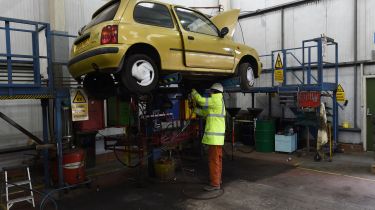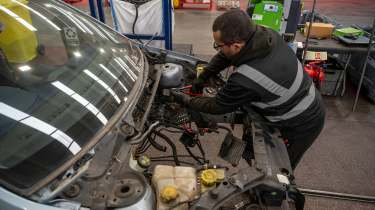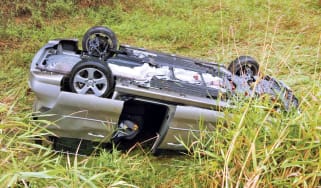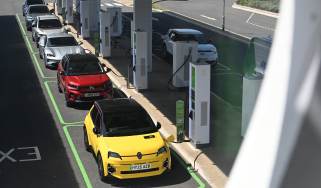Cut and shut cars: what are they and how to spot them
Cut and shut cars can be a fatal hazard on the road, this guide outlines the dangers of a cut and shut car and how to spot one…

Buying a used car can be a great way of saving some money when shopping around for your next car, but under the shine and polish of the bodywork could be the hidden dangers of a cut and shut car.
A cut and shut car is created when the remains of two previously crash damaged cars are welded together to create a whole car. This amalgamation of two different vehicles is then disguised as a legitimate used car, often by dodgy dealers or sellers looking to hide the real history and structural damage of a vehicle to make a quick profit.
It is illegal to tamper with a vehicle’s identity and to misrepresent a vehicle’s history to a prospective buyer. There are, however, avenues through which cars that are put together from parts of other vehicles can be legally sold. Our advice would be to avoid cut and shut cars in all cases.
Knowing how to spot the warning signs of a cut and shut car is essential when buying a second-hand car, as cut and shut cars are often structurally unsound, which can be fatal in the event of an accident. Below you’ll discover the dangers of a cut and shut car and how to check for tell-tale warning signs of a cut and shut car.
What is a cut and shut car?
A cut and shut car is made by welding together the undamaged sections of two separate crash-damaged vehicles, typically the front end of one car and the rear end of another. This is often done when both cars have been involved in an accident and then written off, the aim being to create a complete, roadworthy car which is then sold-on without disclosing the full history to the buyer.
Individuals who create cut and shut cars put a considerable amount of effort into hiding the identity of the two vehicles by cutting, welding and repainting the bodywork to create the illusion of a respectable, used car.
However, appearances can be deceiving. Beneath the surface shine, the car’s original structural integrity and safety standards have been severely compromised. The standards intended by the manufacturer and once proven in Euro NCAP safety tests no longer apply, which could have fatal consequences in the event of a crash.

The dangers of a cut and shut car
While on the surface a cut and shut car might look identical to a model which hasn’t been involved in a crash, it’s often a different story under the metal.
Structural integrity
As a cut and shut car is created when two halves of different cars are welded together, the vehicle will no longer reach the original safety standards intended by the manufacturer.
If a cut and shut car was then involved in a collision, the new welding spots can become weak points and are prone to failure, crumpling or splitting apart in places which were originally designed to be safety cells for passengers.
Unpredictable behaviour on the road
The vehicles used to create a cut and shut car might be an identical make, model or even spec, but the condition of both car halves will vary - with suspension or braking components wearing at different rates.
These critical components might even have unknown damage which can lead to unpredictable handling or underperformance, especially during emergency manoeuvres.
Hidden damage and roadworthiness
Because two vehicles are stitched together, other issues may be hidden beneath the surface. The accidents which led to the cars being written off and used as donor cars for a cut and shut might have caused unseen damage or structural weakening, which can lead to unexpected failure.
Invalid car insurance
You must always do your due diligence when buying a used car. If you discover that the car you’re looking at is a cut and shut car, do not buy or drive it. Any car insurance policy taken out against the vehicle would be at risk of being void in the event of an accident. This means you could be fined £300 and receive six penalty points on your licence.
You could also be liable for any damage caused to third parties, even if you purchased the vehicle not knowing it was a cut and shut.
Are cut and shut cars illegal?
When cars are written-off by the insurance company after an accident, they receive a write-off category rating and it is illegal to return cars, or parts of cars, in some categories to the road.
It is possible to legally repair accident damaged cars using parts from other vehicles but not to disguise their identity, either by tampering with the VIN number or failing to disclose the nature of the vehicle at the point of sale.
Cars that are heavily composed of components taken from other vehicles or ‘radically altered’, such as in the case of a ‘cut and shut’, must be re-registered with the DVLA after a type approval test. So while the re-sale of a cut and shut car can be legal, they are best avoided by all but the most experienced buyers. The UK Government website has more information about radically altered vehicles.

How to spot a cut and shut car
No matter how good the welder or mechanic is, there will always be some tell-tale signs which should highlight a cut and shut car, especially if you know where to look. Outlined below are the key areas which would make a cut and shut car stand out…
- Bodywork: Cut and shut cars are usually welded at the top of the rear windscreen and through the C-pillars. Pay close for uneven panel gaps or bodywork which could be an indicator of historic crash damage.
- Paintwork: It’s likely that at least one of the two cars used in a cut and shut will have some evidence of a paint respray or irregularities in the paint shade, even if the two cars used were the same colour. Look for overspray around the door handles, seals, boot and bonnet, as well as dull or cloudy paint finishes.
- Interior trim: Similarly to a car's paint finish, look for irregularities in the upholstery and interior. Mismatched shades could indicate that interior trim has come from two different cars. Examine the condition of the carpet in the boot, headlining and door frames, looking specifically for distortion marks or creases.
- VIN numbers: Does the vehicle identification number (VIN) match up with the VIN on the car and corresponding paperwork? If you see two different VIN numbers, the car is cut and shut and you should walk away. You should be able to find a car’s VIN number in the engine block, inside the driver’s side door and inside the rear wheel well.
- Paperwork: While a car’s paperwork won’t give you definitive answers, you’re looking for irregularities which should raise some alarm bells. Are there gaps in the car's service history? Is the mileage consistent with the car’s MoT history? Have important documents like the V5C logbook gone missing?
Before you hand over any hard earned money, you can conduct an HPI background check into a vehicle's history. Here you’ll be able to get an accurate report showing the history of the car you’re looking at, which will help correspond with any vehicle documents. A HPI check will also highlight if the car has been written off. You should also get the car mechanically inspected by an independent mechanic for extra piece of mind.
Did you know you can buy a used car with Auto Express? Choose from tens of thousands of cars with trusted dealers around the UK. Click here to buy used with Auto Express now...
Find a car with the experts








